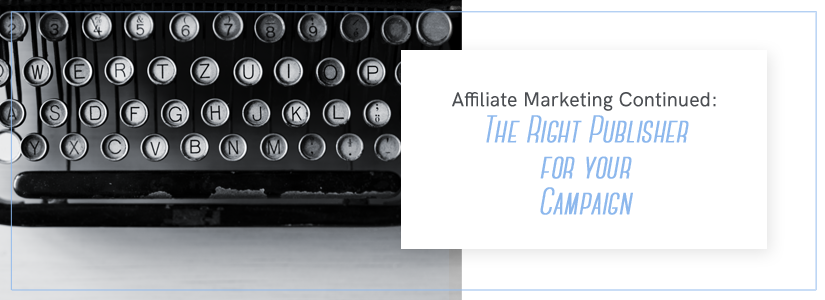
Affiliate Marketing Part II: The Right Publisher for Your Campaign
In Part I of our Affiliate Marketing discussion, we went over the basics—what affiliate marketing is and what affiliate publishers can do for advertisers. But there are so many options, and so now we need to take a look at what type of affiliate advertising will best meet your goals.
Finding the Right Forum
Affiliate marketing can be done in a ton of places—blogs, discussion forums, social media, TV or print media. To choose the right forum for your campaign, it’s important to think about the audience you want to reach and what type of information they are most responsive to. These are some of the online options that let you connect with buyers with different needs:
1. Content-focused publishers. If you want to reach an audience based on an interest niche, blogs and content-focused websites can be a good source for reaching interested and dedicated readers.
2. Review-based sites and comparison forums. If your product has a strong competitive advantage or you want to focus on differentiating the product, review sites will reach readers who want that type of research, possibly with the added push of a personal recommendation.
3. Coupon sites. Want to reach people who are looking for a good deal? Get buyers excited to try your product by making special offers through coupon sites.
4. Social media partners. Reach out to an audience by creating buzz with social media partners, who can generate likes, follows and even reviews.
5. Loyalty programs. Partner with sites that offer cashback and other rewards to reach an audience by offering that added incentive to buy.
Thinking about Affiliate Publisher Pay
Part of finding the right partner is working with your budget. Publishers work on different pay agreements, so you’ll need to research which partner fits your budget as well as your audience.
1. Pay per click (PPC) affiliate marketing. Each time a reader clicks on a link, the advertiser will pay for the click. Clicks don’t necessarily mean revenue, so make sure you have a plan to stay within budget when using PPC. For more tips on planning for PPC, check out Elements of E-Commerce: Paid Digital Marketing Using Pay Per Click.
2. Cost per action or cost per lead (CPA/CPL). With CPA, payment is not made until some step beyond the reader clicking the link is completed—maybe the reader has to buy a product, or sign up for a newsletter. When the reader does that triggering action, the advertiser pays the publisher.
3. Cost per impression (CPI). Here, the advertiser pays a publisher for a certain number of times that the publisher’s page is viewed. Again, this doesn’t tie payment to any earned revenue, but that may not matter if the goal of your campaign is increasing the visibility of your product.
Entering the Right Partnership
If the point of an affiliate marketing campaign is to a get an audience to think of you because of your alignment with your affiliate publisher, the best partner is one that feels like an extension of your company. Here are a few things to consider before you decide that you want any of these partners talking about you:
⋅ Will you be able to reach the broad or niche audience you need with this partner?
⋅ What is the affiliate publisher’s brand and is it one that resonates with your buyers?
⋅ Is the publisher following regulations and not using bots to drive traffic?
Wading through all of these options doesn’t have to be something you do on your own. Get in touch and let us help you find the right affiliates and shape a campaign that’s fitted to your goals.

